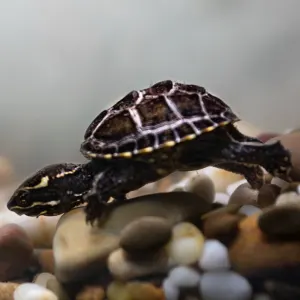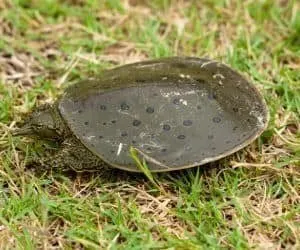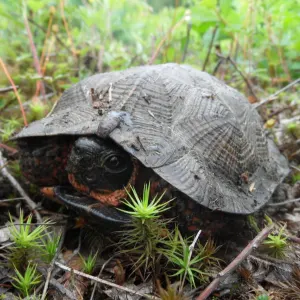There are 11 species of turtles in Minnesota. They are found across the forests, lakes, and prairies of the North Star State. Some species, such as the semi-aquatic Blanding’s turtle and the more terrestrial Wood turtle, are classed as Endangered. Other aquatic species, like the Western Painted turtle and Common Snapping turtle, are widespread across the state.
This list will cover each of Minnesota’s native and non-native species and can function as a herping guide for your next trip out into the field. You could also use this list to help choose your next pet turtle, but bear in mind that there may be state restrictions in Minnesota relating to the possession of native species. Check the state laws before buying any turtle.
To help you out, click on the name or image of each entry on this list to jump to a comprehensive care guide. These pages will include all the information you need to correctly care for your chosen turtle species. We always recommend adopting a turtle from a shelter or rescue center first, but if this isn’t possible, try and buy a captive-bred baby rather than a wild caught specimen.
Minnesota is also home to one non-native species; the Red-eared Slider. We’ll cover this species at the end of our list, but although they can be purchased in Minnesota, it is illegal to release them into the wild.
Now, let’s explore the 11 species of turtles in Minnesota.
Turtles in Minnesota
1. Blanding’s Turtle

- Experience Level: Intermediate
- Family: Emydidae
- Scientific Name: Emydoidea blandingii
- Other Names: N/A
- Adult Size: 5 to 8 inches (12.5 to 20 cm)
- Lifespan: Up to 80 years
- Average Price Range: $300 to $450
Named after William Blanding, an American naturalist, Blanding’s turtles are an endangered species in Minnesota. They inhabit marshes and wetland regions and have been mainly been recorded in Minnesota’s central-eastern and southern counties.
Blanding’s turtles have dark oval shells covered in yellow speckles. Their throats are pure yellow while their plastrons are yellow with black patches. Blanding’s turtles are also known as “the turtle that smiles” because of their characterful expressions.
Blanding’s turtles are omnivorous, mainly eating crustaceans, insects, mollusks, and worms. Occasionally they will eat plants. They are cautious, often diving to safety at any sign of trouble. Blanding’s turtles are threatened by habitat loss and over-collection for the pet trade.
2. False Map Turtle

- Experience Level: Beginner
- Family: Emydidae
- Scientific Name: Graptemys pseudogeographica
- Other Names: Sawback turtle
- Adult Size: 3.5 to 10.5 inches (9 to 26.5 cm)
- Lifespan: 30 to 50 years
- Average Price Range: $6 to $40
False Map turtles usually dwell in larger rivers in Minnesota’s southern counties and rarely travel far from the water. These turtles can sometimes be spotted as they bask on logs and rocky outcrops above the surface of the water.
False Map turtles have dark brown or black shells with contour-like yellow markings. Most adults have a noticeable keels on their backs. To distinguish themselves from other Map turtles, False turtles lack colored patches and markings on their heads.
This species is omnivorous and eats crustaceans, insects, and occasionally aquatic vegetation. They are accomplished swimmers and favor waters with medium currents.
3. Northern Map Turtle

- Experience Level: Beginner
- Family: Emydidae
- Scientific Name: Graptemys geographica
- Other Names: Common Map turtle
- Adult Size: 4 to 10.5 inches (10 to 26.5 cm)
- Lifespan: 15 to 20 years
- Average Price Range: $20 to $60
Northern Map turtles have the widest range of any Map turtle in Minnesota, but they are still confined to larger rivers and streams in southern and central-eastern counties. These fully aquatic turtles are great swimmers and do not venture far from the water.
Northern Map turtles have dark brown or olive green shells and are named for their yellowish markings which resemble the contours of a map. They have saw-like keels protruding from the center of their carapaces. Small yellow spots behind the eyes separate the Northern Map turtle from other subspecies.
These turtles are mainly carnivorous, feeding on crustaceans, small fish, and insects. Crayfish are one of their favorite staples. Northern Map turtles will also eat plants occasionally.
4. Ouachita Map Turtle

- Experience Level: Beginner
- Family: Emydidae
- Scientific Name: Graptemys ouachitensis
- Other Names: Southern Map turtle
- Adult Size: 3.5 to 10 inches (9 to 25.5 cm)
- Lifespan: 15 to 20 years
- Average Price Range: $40 to $100
Ouachita Map turtles are the rarest of Minnesota’s Map turtles, located in a few southeastern counties along the border with Wisconsin. Here, they inhabit larger rivers and streams with moderate currents.
Ouachita Map turtles can be distinguished from other Map turtles by the large lightly-colored patches behind their eyes. They have prominent keels protruding from their dark green shells and yellowish markings that look like contours on a map.
As with many other species, Ouachita Map turtles are omnivores. They mainly eat crustaceans, insects, and mollusks but will occasionally eat algae or aquatic plants. They can be seen basking in groups during the day but are easily startled and will jump into the safety of the water.
5. Eastern Musk Turtle

- Experience Level: Intermediate
- Family: Kinosternidae
- Scientific Name: Sternotherus odoratus
- Other Names: Common Musk turtle, Stinkpot
- Adult Size: 4 to 5 inches (10 to 12.5 cm)
- Lifespan: 50+ years
- Average Price Range: $20 to $90
Eastern Musk turtles are one of Minnesota’s most secretive species, so far only recorded in Olmsted County in southeastern Minnesota. These small aquatic turtles are also known as ‘Stinkpots’ because of the powerful odor that they can release from their musk glands when threatened.
Eastern Musk turtles have dark brown or black unmarked shells. Their heads are also dark, with two yellowish stripes as well as fleshy barbels on their chins and necks. Some specimens may also have clumps of algae growing on their shells.
These nocturnal omnivores mainly eat small amphibians, crustaceans, and mollusks. Eastern Musk turtles prefer boggy or marshy habitats with slow-moving waters.
6. Western Painted Turtle

- Experience Level: Beginner
- Family: Emydidae
- Scientific Name: Chrysemys picta belli
- Other Names: N/A
- Adult Size: 4 to 10 inches (10 to 25.5 cm)
- Lifespan: 30 to 50 years
- Average Price Range: $20 to $50
Western Painted turtles are one of Minnesota’s most common species and are found in shallow rivers, streams, or marshes all across the state. The Western Painted turtle is the largest subspecies of Painted turtle.
These medium-sized aquatic turtles commonly have dark brown, black, or olive green shells. Their plastrons are orange or reddish with vibrant blot-like patterns. Their shells are also edged with yellow.
Western Painted turtles are diurnal omnivores that mainly eat insects and vegetation as well as crustaceans, frogs, and mollusks. They can sometimes be seen wandering around on land, but usually stay near the water where they bask on logs along the shore.
7. Common Snapping Turtle

- Experience Level: Intermediate to Expert
- Family: Chelydridae
- Scientific Name: Chelydra serpentina
- Other Names: Common Snapper, Eastern Snapping turtle, Snapper
- Adult Size: 8 to 20 inches (20 to 51 cm)
- Lifespan: 30 to 50 years
- Average Price Range: $20 to $40
Common Snapping turtles are Minnesota’s most common species. These imposing aquatic turtles prefer larger bodies of water such as lakes, ponds, and rivers. They are at the top of the freshwater food chain in many of their habitats.
Common Snapping turtles are easily identified by their powerful hooked beaks which can crush prey easily. They have dark brown or green shells with a series of three vertical ridges as well as strong claws and long tails bearing saw-toothed spines.
As nocturnal omnivores, Common Snapping turtles mainly eat amphibians, fish ,smaller turtles, and even waterfowl. Occasionally they will also eat plants. If cornered on land, Snapping turtles can hiss and attempt to bite.
8. Smooth Softshell Turtle

- Experience Level: Intermediate to Expert
- Family: Trionychidae
- Scientific Name: Apalone mutica
- Other Names: Pancake turtle, Spineless Softshell
- Adult Size: 4.5 to 14 inches (11.5 to 35.5 cm)
- Lifespan: 25+ years
- Average Price Range: $40 to $60
Smooth Softshell turtles are a medium-sized species that are confined to Minnesota’s southeastern counties. These aquatic turtles prefer larger rivers and require sandbars as part of their habitats. This has left them vulnerable to habitat loss.
Smooth Softshells resemble leathery pancakes with cream to white plastrons. Their brown or gray shells have smoother fronts towards their heads. Smooth softshells have tapered snouts which they use as snorkels while buried in the sand.
These carnivorous turtles bury themselves in shallow sands to ambush unsuspecting prey. They will usually hunt crustaceans, insects, small fish, and mollusks.
9. Spiny Softshell Turtle

- Experience Level: Intermediate to Expert
- Family: Trionychidae
- Scientific Name: Apalone spinifera
- Other Names: N/A
- Adult Size: 5 to 17 inches (12.5 to 43 cm)
- Lifespan: 20 to 50 years
- Average Price Range: $70 to $280
Spiny Softshell turtles are widespread across Minnesota’s central and southern counties, inhabiting rivers and streams with faster-moving currents. These aquatic turtles require sandy substrates within their habitats and are fast swimmers.
Spiny Softshells have a leathery pancake-shaped shell that feels a bit like sandpaper. Their soft carapaces are covered with several dark spot markings with spines on the front edge. They have long, tapered beaks which they use to breathe while buried in the sand and awaiting prey.
These Softshells are carnivores and will feed on any crustaceans, insects, and mollusks that swim past their hiding place. They then lunge forwards and catch their unfortunate prey in their mouths.
10. Wood Turtle

- Experience Level: Intermediate
- Family: Emydidae
- Scientific Name: Glyptemys insculpta
- Other Names: N/A
- Adult Size: 5.5 to 8 inches (14 to 20 cm)
- Lifespan: 40 to 60 years
- Average Price Range: $250 to $500
Wood turtles are one of Minnesota’s most endangered species and are confined to the eastern edge of the state that borders Wisconsin. They mainly inhabit grasslands and woodland regions with easy access to shallow ponds.
Wood turtles get their name from their beautiful brown shells, which have domed scutes that look as if they have been sculpted from wood. Their shells have a rough texture and are covered with patterns that resemble growth rings and wood grain. Their plastrons are yellow with dark patches at the edges.
These diurnal turtles are intelligent and roam widely while looking for food. They are omnivores and often eat berries, plants, mollusks, and worms. They are classed as Endangered due to habitat loss and collection for the pet trade.
Minnesota has also become home to a non-native species; the Red-eared Slider. This species is commonly sold in the pet trade, but has likely been released into the wild by irresponsible owners.
Non Native Turtles in Minnesota
11. Red-eared Slider

- Experience Level: Beginner
- Family: Emydidae
- Scientific Name: Trachemys scripta elegans
- Other Names: Red-eared Terrapin, Water Slider turtle
- Adult Size: 6 to 8 inches
- Lifespan: 20 to 40 years
- Average Price Range: $15 to $50
Red-eared Sliders are semi-aquatic turtles that are one of the most popular species of pet turtle on the market. Unfortunately, these turtles are considered to be invasive in many areas and are often released by unprepared or irresponsible owners. They can quickly spread and become dominant in new areas.
At the present time, Red-eared Sliders are confined to a few southern counties in Minnesota, although they may spread quickly. They prefer warm, slow-moving waters such as rivers and lakes and like to bask at the water’s edge.
Red Eared Sliders have olive green shells with yellowish striped markings on their scutes. Their skin is usually a darker color, with yellow band markings and red patches just behind their eyes. Their plastrons are yellow with dark blotches on each scute.
Frequently Asked Questions about Minnesota turtles
What kind of turtles live in Minnesota?
Minnesota is home to 10 native species of turtle along with one non-native species. Most of Minnesota’s turtles are freshwater aquatic or semi-aquatic species such as Map turtles, Western Painted turtles, Snapping turtles, and Softshells.
There are some endangered or threatened species in Minnesota, such as the Blanding’s turtle and the Wood turtle. The non-native species found in Minnesota is the Red-eared Slider, which may have been introduced through unsafe release from captivity.
Are Box turtles native to Minnesota?
Box turtles are not native to Minnesota, although some scattered specimens might appear if they have been unsafely released from captivity. Box turtles are more prevalent in eastern states (Eastern Box turtles) or the Great Plains region (Ornate Box turtles).
Can you keep Painted turtles as a pet in Minnesota?
Painted turtles can be kept legally as pets in Minnesota. Western Painted turtles are Minnesota’s native subspecies of Painted turtle and may also be taken from the wild. However, it is strongly suggested that you either adopt a Painted turtle from an animal shelter or buy from a reputable captive-breeder.
The only turtles that are illegal to purchase or own as pets in Minnesota are Blanding’s turtles and Wood turtles. Both of these species are endangered or threatened.
What time of year do turtles hatch in Minnesota?
Due to the colder climes in Minnesota, the breeding and laying season for many species of turtle in the North Star State runs from late May through to June. The eggs likely won’t hatch for two or three months, meaning that you can expect turtles to hatch between August and September.
Is it illegal to keep a wild turtle in Minnesota?
Minnesota has relatively relaxed laws regarding pet turtles in Minnesota. The only native species that cannot be sold or owned as a pet are Blanding’s turtles and Wood turtles.
Some wild species may be collected from Minnesota’s habitats. These are the Western Painted turtle, Common Snapping turtle, and Spiny Softshell turtle. You need an angling license or turtle license to take these species.
Wild-caught turtles can be imported into Minnesota, but only if they have been lawfully collected in the state where they were caught.
Conclusion
And that wraps up our list of the 11 turtles found in Minnesota! We’ve covered 10 native and one non-native species on this list, ranging from aquatic turtles such as Common Snappers and Eastern Musk turtles to endangered specimens such as Blanding’s turtles. We’ve also covered Red-eared Sliders, which are Minnesota’s non-native species.
Whether you’re using this list as a field herping guide or a springboard to help you decide on your next pet turtle, we hope you enjoyed it. If you did, feel free to comment down below and discuss Minnesota’s turtles with fellow herping enthusiasts.
Other nearby states
